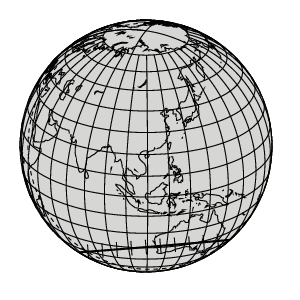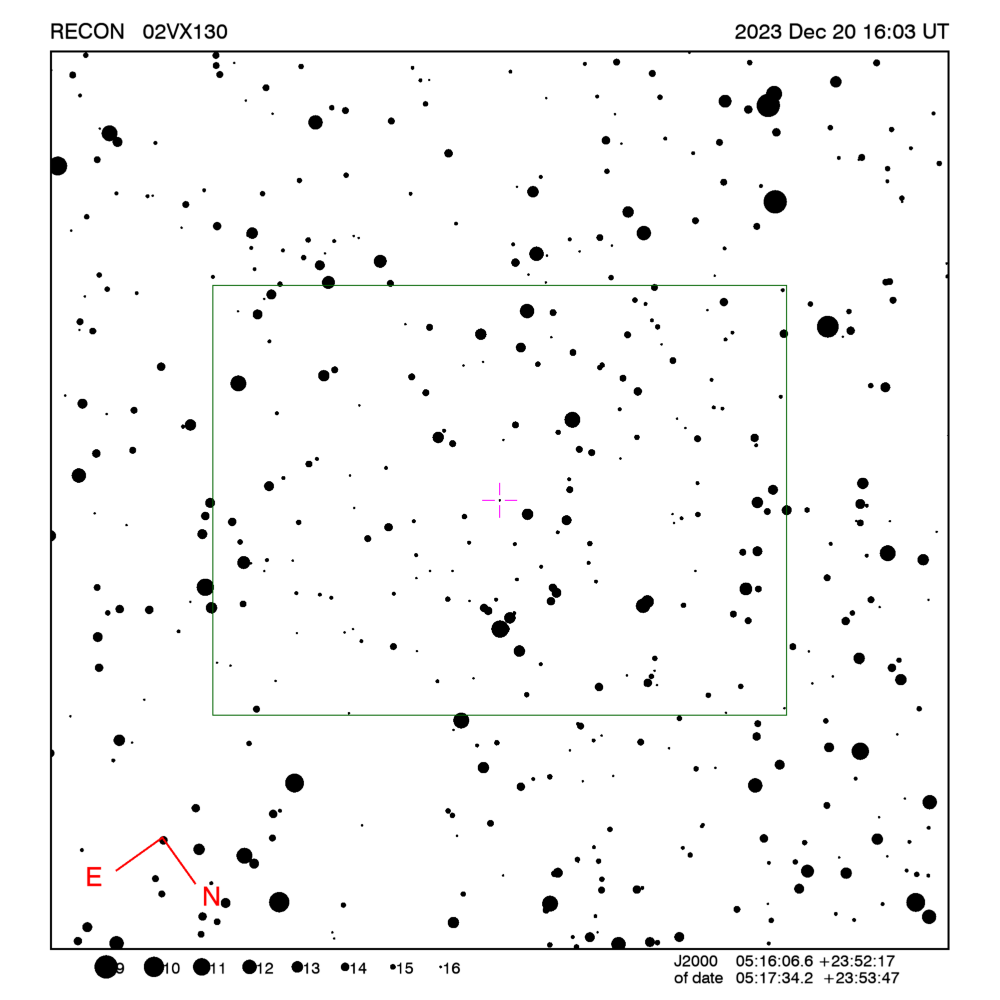RECON: TNO occultation with 02VX130
Event between 02VX130 and star GA1120:01107180
with event index number of 2715500
Geocentric closest approach at 2023/12/20 16:03:12 UTC
J2000 position of star is 05:16:06.6 +23:52:17
Equinox of date position of star is 05:17:26.7 +23:53:39
Stellar brightness G=16.6,
use SENSEUP=128 with the MallinCam and and exposure
time of 2 seconds with the QHY174 camera.
Star is 70 degrees from the moon.
Moon is 60% illuminated.
TNO apparent brightness V=23.3
 TNO is 31.9 AU from the Sun
and 30.9 AU from the Earth.
TNO is 31.9 AU from the Sun
and 30.9 AU from the Earth.
The TNO is moving 24.2
km/sec on the sky relative to the star, or,
3.9 arcsec/hr.
The 1-sigma error in the time of the event is 298 seconds.
The 1-sigma cross-track error in the shadow position is
1877 km.
The TNO has an absolute magnitude Hv=8.3
Diameter=129.4 km assuming a 5% albedo -- 5.3 sec chord
Diameter=52.8 km assuming a 30% albedo -- 2.2 sec chord
Dynamical classification is 3:2E
Star training set for 02VX130, (2023/12/20 16:03UT)
Object RA Dec mag sep mel
Aldebaran 04:37:17.9 +16:33:20 0.8 11.96 60
Alnath 05:27:48.6 +28:37:32 1.6 5.26 73
108 Tau 05:16:54.2 +22:18:36 6.2 1.59 70
PPM 094241 05:18:59.5 +24:02:01 7.9 0.35 70
PPM 094229 05:18:08.4 +24:08:25 9.9 0.28 70
PPM 094198 05:16:23.6 +23:57:45 10.1 0.28 70
02VX130 05:17:34.2 +23:53:47 16.6 70
Positions are for equinox of date

Azimuth is measured in degrees eastward from north.
North is at an azimuth of 0, due East is at an azimuth
of 90 degrees, due South is 180, and due West is 270.
Do not use the listing below for the RECON CPC 1100 telescopes.
This is provided for other non-team facilities.
Star training set for 02VX130, (2023/12/20 16:03UT)
Object RA Dec mag sep mel
Aldebaran 04:35:55.3 +16:30:29 0.8 11.96 60
Alnath 05:26:17.6 +28:36:23 1.6 5.26 73
108 Tau 05:15:27.6 +22:17:05 6.2 1.59 70
PPM 094241 05:17:31.7 +24:00:34 7.9 0.35 70
PPM 094229 05:16:40.6 +24:06:56 9.9 0.28 70
PPM 094198 05:14:56.0 +23:56:12 10.1 0.28 70
02VX130 05:16:06.6 +23:52:17 16.6 70
Positions are for J2000
Event circumstances last updated at 2021/12/02 01:41:43 UT
Marc W. Buie,
Southwest Research Institute
RECON
 TNO is 31.9 AU from the Sun
and 30.9 AU from the Earth.
TNO is 31.9 AU from the Sun
and 30.9 AU from the Earth.
